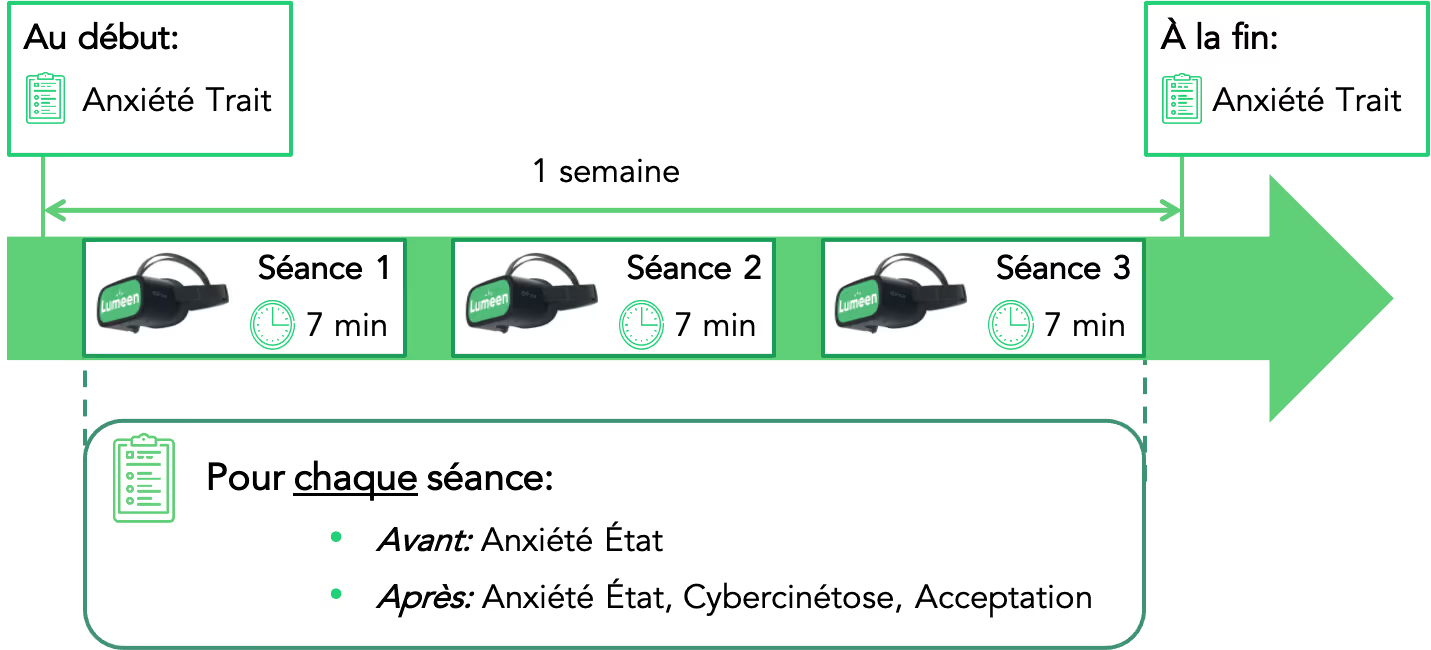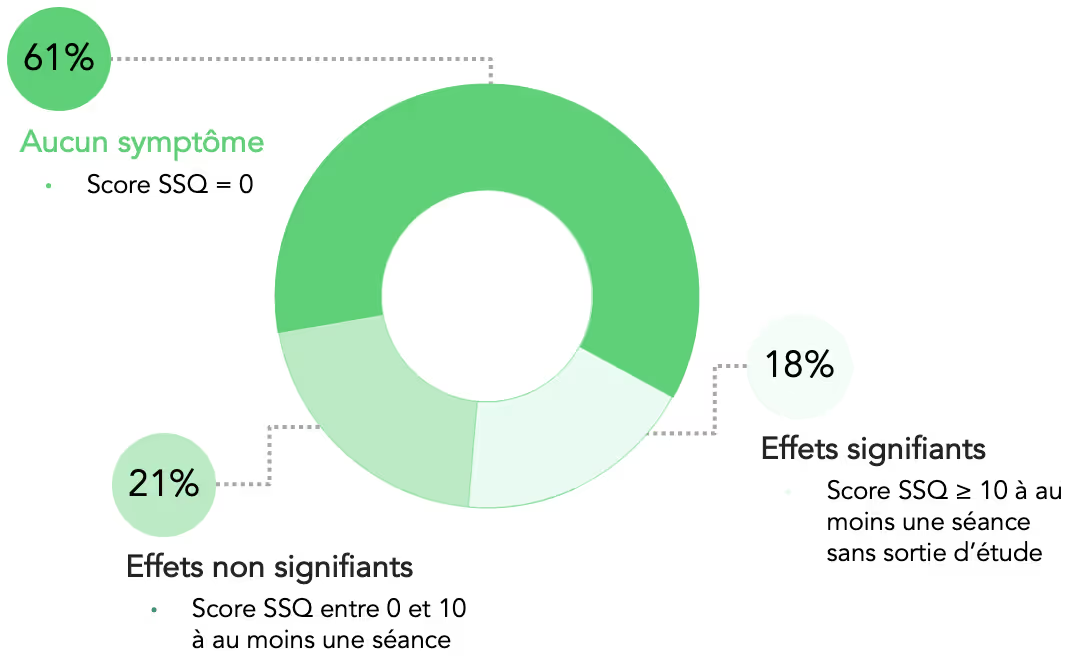A study on the tolerance of virtual reality in nursing homes!
.avif)
One of Lumeen's goals is to develop scientific collaborations in order to assess the benefits of our virtual reality solution. Today, we are happy to present the results of the RAVI study: “Tolerance of the use of Virtual Reality among subjects living in residential establishments for dependent elderly people (EHPAD)”. This study was conducted as part of a thesis at the Institut des Sciences du Sport-Santé de l'Université Paris Cité, in partnership with Gérond'If (the Gérontopôle d'Île-de-France) and Lumeen. It focuses on tolerance (ability of the subject to support the immersive experience at the psychological and physiological level) and acceptance (implicit or explicit agreement of the subject to wear the device) of virtual reality with head-mounted displays in elderly people living in nursing homes.
Tolerance, Acceptance, and Cyberkinetosis
Headsets (also called virtual reality headsets), such as those included in the Lumeen solution, allow the user to be isolated from their environment by stimulating two of their senses (sight and hearing) to give them a feeling of immersion in virtual reality. However, the use of a head-mounted display can sometimes cause cyberkinetosis during or after immersion, which can be an obstacle to the use of this technique.1. Before presenting the results of this new study, let's start by defining what cyberkinetosis is.
What is cyberkinetosis?
This is a common side effect of virtual reality, which has 3 components2 :
- The first component is a feeling of discomfort, even nausea, similar to what one may experience when one suffers from motion sickness. This is due to a sensory conflict between our vision and the vestibular system in our inner ear (responsible for maintaining balance). This happens in particular when the movements that we observe in the head-mounted display do not correspond to what our inner ear perceives (i.e. an absence of movement).3.
- The second component is visual fatigue. It is linked to the significant and rapid variations in light inside the head-mounted display.
- The third component is the disorientation associated with the dissociation between the real world and the virtual world.
In France, 30 to 50% of virtual reality users are affected by cyberkinetosis4. In the majority of cases, these symptoms are mild and disappear after a few minutes. However, some people may be more susceptible to cyberkinetosis (especially when they are prone to motion sickness), which can negatively affect their VR experience. Anxiety related to the appearance of these symptoms can also impact the tolerance of the headphone. It is therefore important for publishers like Lumeen, who are developing solutions intended to be used with fragile audiences, such as elderly people living in nursing homes, to minimize the risk of cyberkinetosis.
Cyberkinetosis is more common with experiences that involve rapid movements and/or sudden changes in perspective. Moreover, regarding the duration of this content, it seems that the longer it is, the higher the risk of cyberkinetosis.2. The Lumeen team works to limit the risk of cyberkinetosis by designing adapted immersive experiences for fragile audiences: short (between 7 and 12 minutes), calm, soothing, with controlled camera movements. Each plan included in the immersions in our catalog is validated by our team of experts, according to a demanding specifications to provide a user experience safe and of high quality.
That said, there is currently little data on cyberkinetosis in nursing home residents. The RAVI study was therefore launched to learn more about the potential negative effects of virtual reality on this audience by evaluating, with a recognized and impartial partner, the acceptance and tolerance of our device among elderly people in nursing homes (average age = 89 years).
Tolerance and acceptance of virtual reality among nursing home residents: results of the RAVI study
The results of this preliminary clinical study were recently published in a recognized scientific journal. We've summarised them for you below.
The main objective of the study was to assess the tolerance of headsets and Lumeen experiences in elderly people living in nursing homes by measuring cyberkinetoses after each session. In addition, the secondary objective was to assess the acceptance and effect of the virtual reality device and scenes designed by Lumeen on the anxiety of residents.
The recruitment of participants took place from July 2021 to January 2022 in eight nursing homes in Île-de-France *. For each participant, the evaluation period took place over a week during which three exposures to virtual reality scenes designed by Lumeen were made. These three immersive experiences (360° videos) from our catalog were offered in random order (Figure 1).

Figure 1. Visualization of the three immersive Lumeen experiences offered to participants.
La toleration to virtual reality was determined using the Simulator Sickness Questionnaire (SSQ). Initially created to assess adverse effects in flight simulators, the use of this questionnaire has expanded with the rise of virtual reality. A total SSQ score of 0 corresponds to an absence of symptoms of cyberkinetosis. A total SSQ score between 0 and 5 means that the signs of intolerance are negligible. A total SSQ score between 5 and 10 is associated with minimal, insignificant intolerance. A total score between 10 and 15 corresponds to significant signs of intolerance and a total score between 15 and 20 corresponds to worrying symptoms. Finally, a total SSQ score greater than 20 means that the simulator is bad5.
THEanxiety was assessed via behavioral measures (State and Trait Anxiety Inventory; STAI-Y A or B). THEAnxiety state was measured before and after each session using the STAI-YA. This questionnaire makes it possible to assess the level of anxiety transitory of a subject during a specific situation that is potentially anxiety-provoking (here, during the virtual reality session). The Anxiety trait was, for its part, measured at the beginning and at the end of participation in the study using the STAI-YB, which assesses the level of anxiety general of a subject (which often depends on his personality).
THEacceptance was measured after each session using a user experience questionnaire specifically created for this study.

Figure 2. Schematic representation of the protocol over time with the order in which the various questionnaires were passed.
Thirty-six nursing home residents agreed to participate in the study. Among them, one participant dropped out after the first session due to a lack of motivation and two others due to an intolerance to virtual reality that was manifested by cyberkinetosis.
Among the thirty-three participants (average age 89) who completed the entire study:
- 61% Did not feel no symptoms cyberkinetosis during the various immersive sessions,
- 21% have felt negligible or minimal effects that are not significant during at least one session,
- 18% have felt significant effects for at least one session out of the three completed. These results are shown on the Figure 3.

Figure 3. Level of tolerance of participants during virtual reality sessions.
The subjects' anxiety trait did not vary significantly between before and after the experiment. In contrast, the average anxiety state scores associated with the virtual reality experience did not increase and even decreased significantly between the start and the end of each session. This is in favor of a good tolerance of the Lumeen immersive experience.
When asked about the acceptance of head-mounted displays, residents are very satisfied with their use with an average overall score of 29.9/36 on the questionnaire and reported a high intention to use (4.31/6 on average).
The take-home message
- The scenes developed by Lumeen and used in this study are tolerated by the majority of the elderly people included in this study,
- This tolerance results in a Absence/few symptoms of cyberkinetosis And a reduction in anxiety during immersive reality sessions,
- The residents interviewed in this study are Satisfied of the device and report a high intention of use.
To go further...
Studies suggest that the probability of being prone to cyberkinetosis depends a lot on the individual characteristics of each person (sensitivity to motion sickness, gender, age, the presence of a neurological disorder and/or the presence of a phobia)6. In particular, an earlier study showed that susceptibility to cyberkinetosis decreased with age.7. In the RAVI study, analyses failed to establish a link between participants' individual factors (age, cognitive ability, anxiety level, and psychological well-being) and the onset of cyberkinetosis.
It should also be noted that the use of SSQ to measure cyberkinetosis has some limitations. As explained earlier, this questionnaire is not specific to cyberkinetosis but was originally intended for military personnel using flight simulators. These SSQ scores may be different in the general population and tend to be higher in virtual environments different from flight simulators.8.9. The appearance of new validated and standardized questionnaires specific to the evaluation of cyberkinetosis, such as the Cybersickness in VR Quiz (CSQ-VR), for example, could allow for a more accurate measurement of these symptoms in the future.
Thanks
We thank the authors of the article Hajer Rmadi, Pauline Maillot, Pauline Maillot, Romain Maillot, Romain Artico, Edouard Baudouin, Sylvain Hanneton, Gilles Dietrich, and Emmanuelle Duron for using the virtual environments designed by Lumeen to conduct this research. They are part of the VIRTUAGE project, which has received financial support from the Île-de-France Region in the form of a doctoral grant: “Paris Region PhD.2 ”. We also thank our partners in the VIRTUAGE consortium: Gérond'if and Paris Cité University.
.avif)
Action supported by the Ile-de-France Region.
*Partner centers:
EHPAD Georges Léger, 4 Avenue du Général-Leclerc — 94600 Choisy-Le-Roi
EHPAD Residence Zemgor, 33, rue du Marray — 95240 Cormeilles-en-Parisis
Nursing home La Roseraie, 11 rue Paul Demange —78290 Croissy-Sur-Seine
EHPAD La Maison de la Chataigneraie, 35 Chemin Royal — 91310 Leuville sur Orge
Ferrari House — Order of Malta, 1, place Ferrari — 92140 Clamart
Nursing home Le Hameau de Mesly, 60, avenue du Dr Paul Casalis — 94000 Créteil
Nursing home The Clematis House, 44, rue de la Dauphine — 91100 Corbeil-Essonnes
EHPAD la Maison du Grand Chêne, 20, rue de l'Abreuvoir — 77380 Combs-la-Ville
Bibliography
(1) LaViola, J.J. (2000). A discussion of cybersickness in virtual environments. ACM SIGCHI Newsletter, 32(1), 47‑56. https://doi.org/10.1145/333329.333344
(2) Saredakis, D., Szpak, A., A., A., Birckhead, A., A., A.,, Birckhead, B., B., Keage, H.A.D., Rizzo, A., & Loetscher, A., & Loetscher, T. (2020). Factors Associated With Virtual Reality Sickness in Head-Mounted Displays: A Systematic Review and Meta-Analysis. Frontiers in Human Neuroscience, 14, 96. https://doi.org/10.3389/fnhum.2020.00096
(3) McCauley, M.E. & Sharkey, T.J. (1992). Cybersickness: Perception of Self-Motion in Virtual Environments. Presence: Teleoperators and Virtual Environments, 1 (3): 311—318. https://doi.org/10.1162/pres.1992.1.3.311
(4) HANDLES. (2020). Health effects associated with exposure to virtual and/or augmented reality technologies.
(5) Stanney, K.M., Kennedy, R.S., & Drexler, J.M. (1997). Cybersickness is Not Simulator Sickness: Proceedings of the Human Factors and Ergonomics Society Annual Meeting. https://doi.org/10.1177/107118139704100292
(6) Howard, M.C., & Van Zandt, E.C. (2021). A meta-analysis of the virtual reality problem: Unequal effects of virtual reality sickness across individual differences. Virtual Reality, 25(4), 1221-1246. https://doi.org/10.1007/s10055-021-00524-3
(7) Paillard, A.C., Quarck, G., G., Paolino, G., G., Paolino, G., G., Paolino, G., G., Paolino, G., G., Paolino, G., G., Paolino, F., F., Denise, P., Paolino, M., Golding, J.F., & Ghulyan-Bedikian, V. (2013). Motion sickness susceptibility in healthy subjects and vestibular patients: Effects of gender, age and trait-anxiety. Journal of Vestibular Research, 23(4‑5), 203‑209. https://doi.org/10.3233/VES-130501
(8) Stanney, K.M., & Kennedy, R.S. (1997). The psychometrics of cybersickness. Communication of the ACM. 40, 66—68. https://doi.org/10.1145/257874.257889
(9) Kennedy, R.S., Drexler, J.M., Compton, J.M., Compton, D.E., Compton, D.E., Compton, D.E., Stanney, K.M., Lanham, D.S., & Harm, D.L. (2003). “Configural scoring of simulator sickness, cybersickness and space adaptation syndrome: similarities and differences,” in Virtual and Adaptive Environments: Applications, Implications, and
Human Performance Issues, eds L. J. Hettinger and M. W. Haas (Lawrence Erlbaum Associates Publishers), 247-278. https://doi.org/10.1201/9781410608888.ch12
Want to test Lumeen for 30 days with no commitment?


.avif)

%25201.avif)

